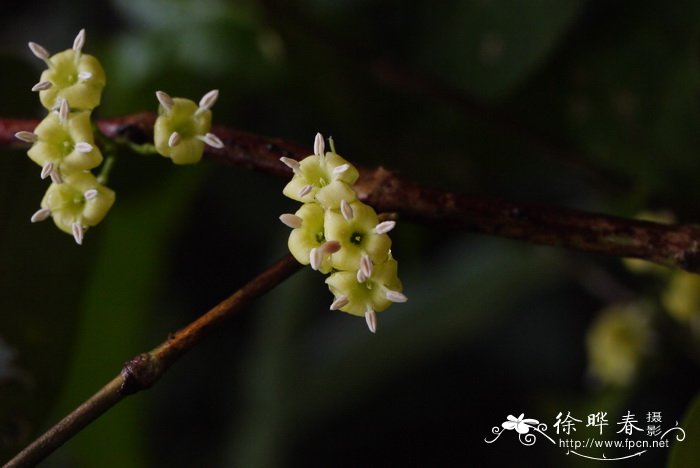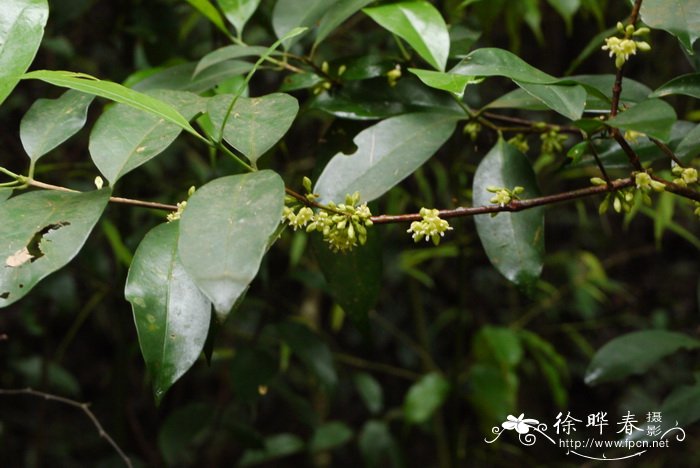狗骨柴Diplospora dubia
中文名(Chinese Name):狗骨柴
学名(Scientific Name):Diplospora dubia (Lindl.) Masam.
英文名(English Common Name):
别名(Chinese Common Name):三萼木
异名(Synonym):Canthium dubium Lindl. Diplospora buisanensis Hayata Diplospora tanakai Hayata Diplospora viridiflora DC. Tricalysia dubia (Lindl.) Ohwi Tricalysia lutea Hand.-Mazz. Tricalysia viridiflora var. buisanensis (Hayata) Yamam. Tricalysia viridiflora var. tanakai (Hayata) Yamam. Tricalysia viridiflora (DC.) Matsum. Hypobathrum viridiflorum (DC.) Baill. Gardenia daphnoides Hance Canthium viridiflorum D.Dietr. Discospermum dubium (Lindl.) Kuntze Diplospora viridiflora var. tanakai (Hayata) Yamam. Diplospora viridiflora var. tanakae (Hayata) Yamam. Diplospora tanakae Hayata Tricalysia viridiflora var. tanakae (Hayata) Yamam.
科属(Family & Genus):茜草科(Rubiaceae)狗骨柴属
形态特征(Description):灌木或乔木,高1-12米。叶革质,少为厚纸质,卵状长圆形、长圆形、椭圆形或披针形,长4-19.5厘米,宽1.5-8厘米,顶端短渐尖、骤然渐尖或短尖,尖端常钝,基部楔形或短尖、全缘而常稍背卷,有时两侧稍偏斜,两面无毛,干时常呈黄绿色而稍有光泽;侧脉纤细,5-11对,在两面稍明显或稀在下面稍凸起;叶柄长4-15毫米;托叶长5-8毫米,下部合生,顶端钻形,内面有白色柔毛。花腋生密集成束或组成具总花梗、稠密的聚伞花序;总花梗短,有短柔毛;花梗长约3毫米,有短柔毛;萼管长约1毫米,萼檐稍扩大,顶部4裂,有短柔毛;花冠白色或黄色,冠管长约3毫米,花冠裂片长圆形,约与冠管等长,向外反卷;雄蕊4枚,花丝长2-4毫米,与花药近等长;花柱长约3毫米,柱头2分枝,线形,长约1毫米。浆果近球形,直径4--9毫米,有疏短柔毛或无毛,成熟时红色,顶部有萼檐残迹;果柄纤细,有短柔毛,长3-8毫米;种子4-8颗,近卵形,暗红色,直径3-4毫米,长5-6毫米。花期4-8月,果期5月至翌年2月。
分布(Distribution):产华东、华南、湖南、四川、云南,生于海拔 40-1500米处的山坡、山谷沟边、丘陵、旷野的林中或灌丛中。日本、越南也有。
用途(Use):本材致密强韧,加工容易,可为器具及雕刻细工用材。据称在江西井冈山地区居民用其根治黄疸病。
引自中国植物志英文版:FOC Vol. 19 Page 99 | Rubiaceae | Diplospora
Diplospora dubia (Lindley) Masamune, Trans. Nat. Hist. Soc. Formosa. 29: 269. 1939.
狗骨柴 gou gu chai
Canthium dubium Lindley, Bot. Reg. 12: t. 1026. 1826; Diplospora buisanensis Hayata; D. tanakae Hayata; D. viridiflora Candolle; Tricalysia dubia (Lindley) Ohwi; T. lutea Handel-Mazzetti; T. viridiflora (Candolle) Masamune; T. viridiflora var. buisanensis (Hayata) Yamamoto; T. viridiflora var. tanakae (Hayata) Yamamoto.
Shrubs or trees, 1-12 m; branches terete to somewhat flattened, glabrous. Petiole 4-15 mm, glabrous; leaf blade drying leathery or rarely thickly papery, and yellowish green to brown, ovate-oblong, elliptic-oblong, elliptic, or lanceolate, 4-19.5 × 1.5-8 cm, both surfaces glabrous and rather shiny, base acute, cuneate, or obtuse, sometimes slightly oblique, margins often thinly revolute, apex acute to acuminate with tip often ultimately obtuse; secondary veins 5-11 pairs, without domatia; stipules persistent on distalmost 1 or 2(-4) nodes, ovate to triangular, 5-8 mm, glabrous, densely white sericeous inside, acute, keeled in upper part with keel often extending into an arista 1-4 mm. Inflorescences subcapitate to congested-fasciculate, 6-10 mm, puberulent to strigillose, tomentulose, or puberulent, sessile or subsessile; bracts triangular, ca. 1 mm, frequently fused in pairs, acute; pedicels 1-4 mm. Calyx strigillose to glabrescent; ovary portion obconic to obovoid, 0.5-1 mm; limb ca. 1 mm, 4-denticulate, sometimes also irregularly splitting. Corolla white or yellow, glabrous outside or sometimes strigose on tube; tube 2-3 mm; lobes elliptic-oblong to narrowly elliptic, 3-4 mm, obtuse. Fruiting pedicels to 8 mm. Berry red, subglobose, 4-9 mm in diam., sparsely strigillose to glabrous; seeds dark red, subovoid, 3-6 × 3-4 mm. Fl. Apr-Aug, fr. May-Feb of following year.
Thickets or forests on hillsides, ravines, fields; near sea level to 1500 m. Anhui, Fujian, Guangdong, Guangxi, Hainan, Hunan, Jiangsu, Jiangxi, Sichuan, Taiwan, Yunnan, Zhejiang [Japan, Vietnam].
This is one of the most commonly collected Rubiaceae species in China.


(责任编辑:徐晔春)
学名(Scientific Name):Diplospora dubia (Lindl.) Masam.
英文名(English Common Name):
别名(Chinese Common Name):三萼木
异名(Synonym):Canthium dubium Lindl. Diplospora buisanensis Hayata Diplospora tanakai Hayata Diplospora viridiflora DC. Tricalysia dubia (Lindl.) Ohwi Tricalysia lutea Hand.-Mazz. Tricalysia viridiflora var. buisanensis (Hayata) Yamam. Tricalysia viridiflora var. tanakai (Hayata) Yamam. Tricalysia viridiflora (DC.) Matsum. Hypobathrum viridiflorum (DC.) Baill. Gardenia daphnoides Hance Canthium viridiflorum D.Dietr. Discospermum dubium (Lindl.) Kuntze Diplospora viridiflora var. tanakai (Hayata) Yamam. Diplospora viridiflora var. tanakae (Hayata) Yamam. Diplospora tanakae Hayata Tricalysia viridiflora var. tanakae (Hayata) Yamam.
科属(Family & Genus):茜草科(Rubiaceae)狗骨柴属
形态特征(Description):灌木或乔木,高1-12米。叶革质,少为厚纸质,卵状长圆形、长圆形、椭圆形或披针形,长4-19.5厘米,宽1.5-8厘米,顶端短渐尖、骤然渐尖或短尖,尖端常钝,基部楔形或短尖、全缘而常稍背卷,有时两侧稍偏斜,两面无毛,干时常呈黄绿色而稍有光泽;侧脉纤细,5-11对,在两面稍明显或稀在下面稍凸起;叶柄长4-15毫米;托叶长5-8毫米,下部合生,顶端钻形,内面有白色柔毛。花腋生密集成束或组成具总花梗、稠密的聚伞花序;总花梗短,有短柔毛;花梗长约3毫米,有短柔毛;萼管长约1毫米,萼檐稍扩大,顶部4裂,有短柔毛;花冠白色或黄色,冠管长约3毫米,花冠裂片长圆形,约与冠管等长,向外反卷;雄蕊4枚,花丝长2-4毫米,与花药近等长;花柱长约3毫米,柱头2分枝,线形,长约1毫米。浆果近球形,直径4--9毫米,有疏短柔毛或无毛,成熟时红色,顶部有萼檐残迹;果柄纤细,有短柔毛,长3-8毫米;种子4-8颗,近卵形,暗红色,直径3-4毫米,长5-6毫米。花期4-8月,果期5月至翌年2月。
分布(Distribution):产华东、华南、湖南、四川、云南,生于海拔 40-1500米处的山坡、山谷沟边、丘陵、旷野的林中或灌丛中。日本、越南也有。
用途(Use):本材致密强韧,加工容易,可为器具及雕刻细工用材。据称在江西井冈山地区居民用其根治黄疸病。
引自中国植物志英文版:FOC Vol. 19 Page 99 | Rubiaceae | Diplospora
Diplospora dubia (Lindley) Masamune, Trans. Nat. Hist. Soc. Formosa. 29: 269. 1939.
狗骨柴 gou gu chai
Canthium dubium Lindley, Bot. Reg. 12: t. 1026. 1826; Diplospora buisanensis Hayata; D. tanakae Hayata; D. viridiflora Candolle; Tricalysia dubia (Lindley) Ohwi; T. lutea Handel-Mazzetti; T. viridiflora (Candolle) Masamune; T. viridiflora var. buisanensis (Hayata) Yamamoto; T. viridiflora var. tanakae (Hayata) Yamamoto.
Shrubs or trees, 1-12 m; branches terete to somewhat flattened, glabrous. Petiole 4-15 mm, glabrous; leaf blade drying leathery or rarely thickly papery, and yellowish green to brown, ovate-oblong, elliptic-oblong, elliptic, or lanceolate, 4-19.5 × 1.5-8 cm, both surfaces glabrous and rather shiny, base acute, cuneate, or obtuse, sometimes slightly oblique, margins often thinly revolute, apex acute to acuminate with tip often ultimately obtuse; secondary veins 5-11 pairs, without domatia; stipules persistent on distalmost 1 or 2(-4) nodes, ovate to triangular, 5-8 mm, glabrous, densely white sericeous inside, acute, keeled in upper part with keel often extending into an arista 1-4 mm. Inflorescences subcapitate to congested-fasciculate, 6-10 mm, puberulent to strigillose, tomentulose, or puberulent, sessile or subsessile; bracts triangular, ca. 1 mm, frequently fused in pairs, acute; pedicels 1-4 mm. Calyx strigillose to glabrescent; ovary portion obconic to obovoid, 0.5-1 mm; limb ca. 1 mm, 4-denticulate, sometimes also irregularly splitting. Corolla white or yellow, glabrous outside or sometimes strigose on tube; tube 2-3 mm; lobes elliptic-oblong to narrowly elliptic, 3-4 mm, obtuse. Fruiting pedicels to 8 mm. Berry red, subglobose, 4-9 mm in diam., sparsely strigillose to glabrous; seeds dark red, subovoid, 3-6 × 3-4 mm. Fl. Apr-Aug, fr. May-Feb of following year.
Thickets or forests on hillsides, ravines, fields; near sea level to 1500 m. Anhui, Fujian, Guangdong, Guangxi, Hainan, Hunan, Jiangsu, Jiangxi, Sichuan, Taiwan, Yunnan, Zhejiang [Japan, Vietnam].
This is one of the most commonly collected Rubiaceae species in China.
(责任编辑:徐晔春)
踩一下[0]

顶一下[0]